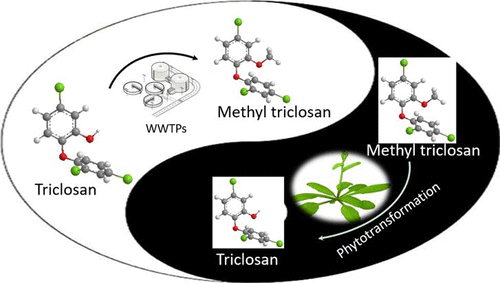当前位置:
X-MOL 学术
›
Environ. Sci. Technol. Lett.
›
论文详情
Our official English website, www.x-mol.net, welcomes your feedback! (Note: you will need to create a separate account there.)
Back Conversion from Product to Parent: Methyl Triclosan to Triclosan in Plants
Environmental Science & Technology Letters ( IF 10.9 ) Pub Date : 2018-02-26 00:00:00 , DOI: 10.1021/acs.estlett.8b00071 Qiuguo Fu 1, 2 , Chunyang Liao 1 , Xinyu Du 1 , Daniel Schlenk 1 , Jay Gan 1
Environmental Science & Technology Letters ( IF 10.9 ) Pub Date : 2018-02-26 00:00:00 , DOI: 10.1021/acs.estlett.8b00071 Qiuguo Fu 1, 2 , Chunyang Liao 1 , Xinyu Du 1 , Daniel Schlenk 1 , Jay Gan 1
Affiliation

|
Numerous man-made chemicals pass through wastewater treatment plants (WWTPs), where biological and chemical treatments often result in the formation of a wide range of transformation products via reactions such as conjugation and alkylation. Such transformation products may come into contact with plants when treated wastewater and biosolids are used in agricultural production or when plants are used for mitigation purposes (e.g., treatment wetlands). Using the high-volume antimicrobial triclosan as a model compound, we showed that its primary transformation product in the WWTPs, methyl triclosan, was readily converted back to the parent in plants. Upon exposure to environmentally relevant concentrations of methyl triclosan, triclosan was detected in Arabidopsis thaliana cells within 12 h, and the level of triclosan increased over time. The molar fraction of triclosan to methyl triclosan in the cells was estimated to be 0.17 at 144 h. When grown in a nutrient solution containing methyl triclosan, lettuce and carrot seedlings were also capable of transforming methyl triclosan back to triclosan after 4 days, with triclosan levels reaching >10 μg/g in lettuce tissues and >3 μg/g in carrot tissues. The back and forth conversions of triclosan in various environmental compartments effectively prolong its environmental persistence and exposure. Future assessment of this and other emerging contaminants should consider such interconversions to obtain a better understanding of their fate and risks.
中文翻译:

从产品向母体的反向转化:植物中的甲基三氯生转化为三氯生
许多人造化学物质通过废水处理厂(WWTP),在该厂中,生物和化学处理通常会通过共轭和烷基化等反应形成多种转化产物。当将经过处理的废水和生物固体用于农业生产或将植物用于缓解目的(例如,处理湿地)时,此类转化产品可能会与植物接触。使用大量的抗菌剂三氯生作为模型化合物,我们证明了其在污水处理厂中的主要转化产物甲基三氯生很容易在植物中转化回亲本。暴露于环境相关浓度的甲基三氯生后,在拟南芥中检测到三氯生在12小时内细胞凋亡,并且三氯生的水平随时间增加。在144小时时,细胞中三氯生与甲基三氯生的摩尔分数估计为0.17。当在含有三氯生甲基的营养液中生长时,生菜和胡萝卜幼苗还能够在4天后将三氯生甲基转化回三氯生,在莴苣组织中三氯生水平达到> 10μg/ g,在胡萝卜组织中达到> 3μg/ g。三氯生在各种环境区室中的来回转化有效地延长了其环境持久性和暴露时间。对此污染物和其他新兴污染物的未来评估应考虑这种相互转化,以便更好地了解其命运和风险。
更新日期:2018-02-26
中文翻译:

从产品向母体的反向转化:植物中的甲基三氯生转化为三氯生
许多人造化学物质通过废水处理厂(WWTP),在该厂中,生物和化学处理通常会通过共轭和烷基化等反应形成多种转化产物。当将经过处理的废水和生物固体用于农业生产或将植物用于缓解目的(例如,处理湿地)时,此类转化产品可能会与植物接触。使用大量的抗菌剂三氯生作为模型化合物,我们证明了其在污水处理厂中的主要转化产物甲基三氯生很容易在植物中转化回亲本。暴露于环境相关浓度的甲基三氯生后,在拟南芥中检测到三氯生在12小时内细胞凋亡,并且三氯生的水平随时间增加。在144小时时,细胞中三氯生与甲基三氯生的摩尔分数估计为0.17。当在含有三氯生甲基的营养液中生长时,生菜和胡萝卜幼苗还能够在4天后将三氯生甲基转化回三氯生,在莴苣组织中三氯生水平达到> 10μg/ g,在胡萝卜组织中达到> 3μg/ g。三氯生在各种环境区室中的来回转化有效地延长了其环境持久性和暴露时间。对此污染物和其他新兴污染物的未来评估应考虑这种相互转化,以便更好地了解其命运和风险。



























 京公网安备 11010802027423号
京公网安备 11010802027423号